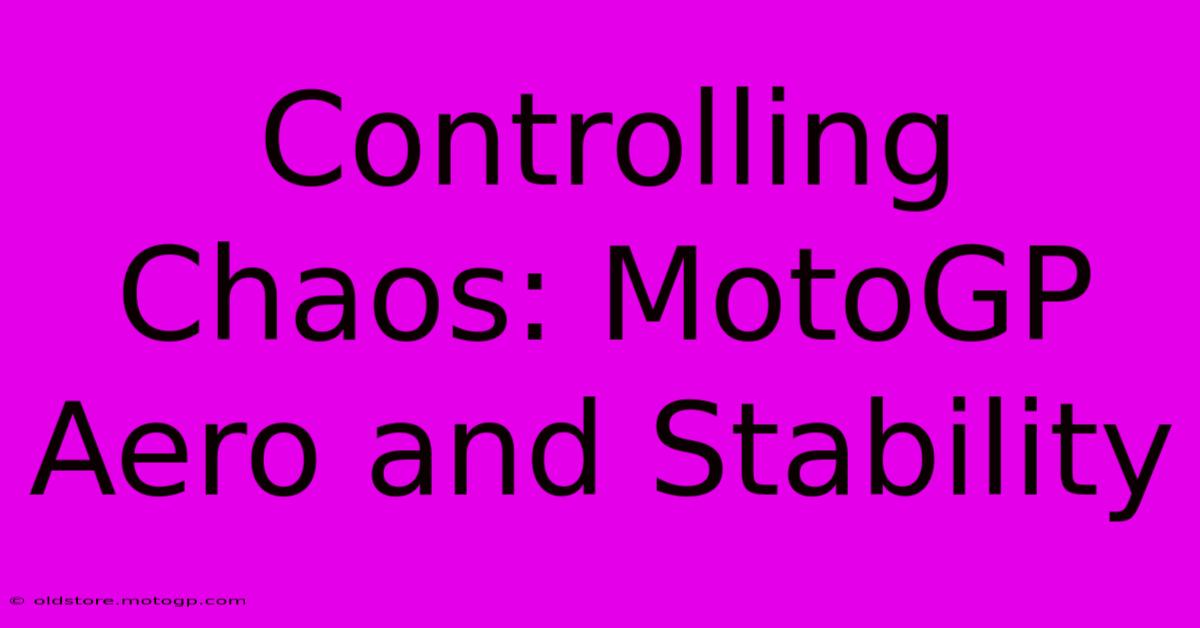Controlling Chaos: MotoGP Aero And Stability

Table of Contents
Controlling Chaos: MotoGP Aero and Stability
MotoGP racing, a spectacle of speed and precision, is a relentless battle against the chaotic forces of nature. At speeds exceeding 200 mph, even the slightest instability can be catastrophic. This is where aerodynamic design and sophisticated rider skill converge to tame the beast, transforming potential disaster into breathtaking displays of control. Understanding the interplay between MotoGP aero and stability is key to appreciating the complexity and brilliance of this motorsport.
The Aerodynamic Arms Race
MotoGP bikes aren't just fast; they're incredibly unstable at high speeds. The sheer force of the wind at these velocities, combined with the bike's lean angles during cornering, creates a complex interplay of aerodynamic forces. Manufacturers are locked in a constant arms race, striving to develop aerodynamic packages that provide crucial downforce without compromising agility or maneuverability.
Downforce: The Grip Generator
Downforce, the downward force generated by aerodynamic elements, is crucial for stability. It presses the tires firmly onto the track, enhancing grip and allowing riders to push harder through corners and maintain stability under braking. Wings, winglets, and carefully sculpted fairings all contribute to generating this vital downforce. The amount of downforce is carefully balanced; too much, and the bike becomes sluggish and difficult to maneuver; too little, and the bike becomes unstable and prone to high-speed wobbles.
Drag: The Speed Thief
While downforce is essential, it comes at a cost. Aerodynamic elements, while generating downforce, also create drag – resistance to forward motion. This drag slows the bike down, making it vital to strike a delicate balance between downforce and minimal drag. Engineers constantly refine designs, employing computational fluid dynamics (CFD) and wind tunnel testing to optimize this crucial balance.
Stability and Rider Input: A Delicate Dance
Even with advanced aerodynamic packages, rider skill remains paramount. The interaction between the bike's aerodynamics and the rider's input is a complex, dynamic system. Experienced riders can subtly adjust their body position and riding style to counteract aerodynamic instability, maintaining control even at the edge of adhesion.
Riding Style and Aero Balance
A rider's weight distribution significantly affects the bike's aerodynamic balance. Leaning into corners, shifting weight, and adjusting body position all contribute to managing the aerodynamic forces acting upon the machine. This nuanced control, honed through years of experience, is essential for maintaining stability and speed.
Electronic Rider Aids: The Safety Net
Modern MotoGP bikes are equipped with sophisticated electronic rider aids like traction control, wheelie control, and cornering ABS. These systems monitor and react to the bike's dynamics, subtly adjusting throttle and brake inputs to prevent loss of traction and maintain stability. These aids work in conjunction with the aerodynamics to provide a crucial safety net, allowing riders to push the limits of performance without sacrificing control.
The Future of MotoGP Aero
The quest for aerodynamic supremacy continues. Expect to see further evolution in wing designs, fairing shapes, and the integration of advanced materials. As computational power increases and simulation techniques improve, we can anticipate even more sophisticated aerodynamic packages, pushing the boundaries of speed and control in MotoGP.
Conclusion:
The control of chaos in MotoGP is a testament to engineering innovation and rider skill. The intricate interplay between aerodynamic design and rider input defines this demanding motorsport, constantly pushing the limits of technology and human capability. The pursuit of ultimate aerodynamic performance continues, promising an ever-evolving spectacle of speed and precision.

Thank you for visiting our website wich cover about Controlling Chaos: MotoGP Aero And Stability. We hope the information provided has been useful to you. Feel free to contact us if you have any questions or need further assistance. See you next time and dont miss to bookmark.
Featured Posts
-
Cota Open Track Days Your Dream Driving Day
Feb 25, 2025
-
The Moto Gp Desmosedici Its Legacy Lives On
Feb 25, 2025
-
Moto Gp Tracks Ticket Information And Booking
Feb 25, 2025
-
Moto Gp Austin 2025 Beyond The Track
Feb 25, 2025
-
Catch Every Moto Gp Race Tnt Sports Schedule Revealed
Feb 25, 2025
